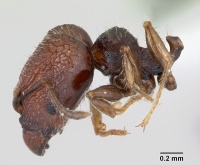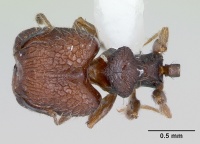Pheidole recondita
| Pheidole recondita | |
|---|---|

| |
| Scientific classification | |
| Kingdom: | Animalia |
| Phylum: | Arthropoda |
| Class: | Insecta |
| Order: | Hymenoptera |
| Family: | Formicidae |
| Subfamily: | Myrmicinae |
| Tribe: | Attini |
| Genus: | Pheidole |
| Species: | P. recondita |
| Binomial name | |
| Pheidole recondita Clouse, 2007 | |
The type material was collected under moss on a tree. Other material was found associated with moss and in a mid-altitude forest.
Identification
Pheidole recondita is one of three extremely small, punctured Pheidole in Micronesia and Melanesia, the other two being Pheidole nindi Mann 1919 and Pheidole philemon Forel 1910a. Although the three majors are quite easily distinguished, the minors are extremely similar and difficult (but not impossible) to distinguish without associated majors. Pheidole recondita and philemon majors are distinguished from nindi by their long frontal lobes: in nindi, linear sculpturing on the frons gradually blends with punctures that lie under the scapes, whereas in recondita and philemon, the two types of sculpturing are distinct and separated by a continuation of the frontal lobes along the length of the scapes. Pheidole recondita and philemon majors are distinguished from each other by the sculpturing of the mesosoma, which is generally more punctate in recondita. Although punctured, philemon is mostly covered with reticulate sculpturing or rugae which become fine transverse ridges on the dorsal pronotum and fade to smooth surface along the lateral mesosoma; recondita has irregular rugae that continue down the sides of the mesosoma, except for distinct, small patches on the lateral pronotum, mes- and metepisterna. A character that is extremely useful to distinguish these three species—even the minors—is their coloration: nindi ranges from light orange to reddish brown, recondita ranges from blackish orange to blackish brown (always with a blackish or ashy appearance), and philemon is bicolored, with a dark brown gaster and ventral petiole and postpetiole and light orange head, mesosoma, and dorsal petiole and postpetiole. Other than color, the minors can be distinguished as follows: nindi and recondita have straight, triangular propodeal spines, while philemon has spines which curve slightly downward; philemon is smoother on the dorsal promesonotum than the other two species, and it has slight transverse rugae on the dorsal mesonotum (nindi and recondita are both heavily punctate over the entire mesonotum); and the dorsal propodeum in recondita is short and convex relative to nindi, which has a relatively long, flat propodeum posterior to a slight anterior rise. (Clouse 2007)
Keys including this Species
Distribution
Only known from a few islands, all in Micronesia.
Latitudinal Distribution Pattern
Latitudinal Range: 7.52011° to 7.51984°.
| North Temperate |
North Subtropical |
Tropical | South Subtropical |
South Temperate |
- Source: AntMaps
Distribution based on Regional Taxon Lists
Indo-Australian Region: Guam (type locality), Marshall Islands, Micronesia (Federated States of), Northern Mariana Islands.
Distribution based on AntMaps
Distribution based on AntWeb specimens
Check data from AntWeb
Countries Occupied
| Number of countries occupied by this species based on AntWiki Regional Taxon Lists. In general, fewer countries occupied indicates a narrower range, while more countries indicates a more widespread species. |

|
Estimated Abundance
| Relative abundance based on number of AntMaps records per species (this species within the purple bar). Fewer records (to the left) indicates a less abundant/encountered species while more records (to the right) indicates more abundant/encountered species. |

|
Biology
Castes
Worker
Images from AntWeb
  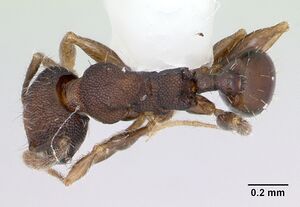 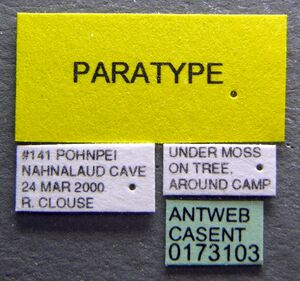
| |
| Paratype of Pheidole recondita. Worker. Specimen code casent0173103. Photographer April Nobile, uploaded by California Academy of Sciences. | Owned by MCZ, Cambridge, MA, USA. |
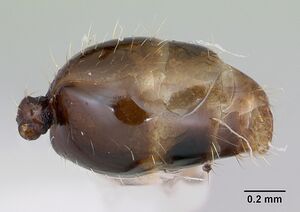 
| |
| Paratype of Pheidole recondita. Worker (major/soldier). Specimen code casent0173102. Photographer April Nobile, uploaded by California Academy of Sciences. | Owned by MCZ, Cambridge, MA, USA. |
   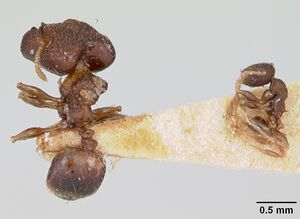 
| |
| Holotype of Pheidole recondita. Worker (major/soldier). Specimen code casent0173104. Photographer April Nobile, uploaded by California Academy of Sciences. | Owned by MCZ, Cambridge, MA, USA. |
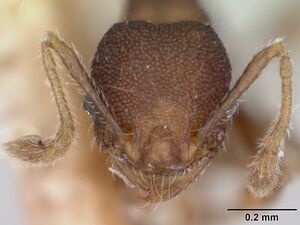    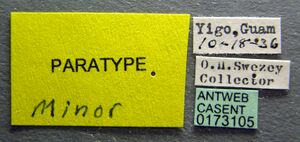
| |
| Paratype of Pheidole recondita. Worker. Specimen code casent0173105. Photographer April Nobile, uploaded by California Academy of Sciences. | Owned by MCZ, Cambridge, MA, USA. |
Nomenclature
The following information is derived from Barry Bolton's Online Catalogue of the Ants of the World.
- recondita. Pheidole recondita Clouse, 2007a: 10, pl. 4 (s.w.) GUAM I. [Also described as new by Clouse, 2007b: 197, 242.]
Unless otherwise noted the text for the remainder of this section is reported from the publication that includes the original description.
Description
Worker
HOLOTYPE MAJOR: TL 2.33, HL 1.02, HW 0.98, CI 97, SL 0.40, SI 41, PW 0.55, ML 0.45. Outer mandibles curved at right angles, apical margins parallel to each other and perpendicular to anterior clypeus. Apical margins worn in holotype but paratype with teeth, described below. Anterior clypeus concave centrally, median clypeus extending to level of antennal insertions, depressed from surface at highest point. Head mostly square, bilobed at vertex. Eyes lateral, at level slightly higher than halfway up scapes. Frontal lobes hiding antennal insertions, scrobes distinct, extending slightly beyond reach of scapes. Antennae 13-segmented, three-segmented club equal in length to remaining funiculus, terminal segment same length as preceding two combined. Promesonotum bulbous in profile, meeting dorsal propodeum at right angle, extended laterally. Propodeal spines as long as height of posterior propodeum, spiracle round and prominent. Petiole angled up from long peduncle, anterior height equal to dorsal length of peduncle. Postpetiole slightly shorter than petiole but expanded to greater width laterally. Color: Overall blackish brown fading to orange at legs and distal scapes through funiculus. Especially blackish at mandibular margins, head along mandibular insertions, proximal scapes, mesepisternum, metepisternum, and posterior gastral tergites. Pilosity: Front of head, vertex, dorsal promesonotum, dorsal petiole and postpetiole, and dorsal gaster with scattered, long, curved, light hairs, especially long and curved on the promesonotum. Sculpturing: Distinguished by extensive puncturing on head, mesosoma, petiole, and postpetiole, even among striae and reticulations; puncturing missing from clypeus, between antennal insertions, and patches on the lateral pronotum, mes- and metepisterna. Reticulate sculpturing at vertex sharp and wide, becoming more linear and losing intermingled punctures at top of scrobes, and ending as linear striae from the middle of the scrobes to the median clypeus. Reticulations continuing down sides of head, becoming more linear around eyes but less distinct among punctures between eyes and antennal insertions, ending in fine linear sculpturing in front of mandibular insertions. Scrobes lined with punctures only. Clypeus and mandibles smooth. Promesonotum covered in loose rugae mixed with punctures, becoming predominated by punctures laterally and between propodeal spines. Lateral pronotum directly under lateral pronotal extensions, mesepisternum, and metepisternum each with glossy area free from punctures and rugae. Petiole and postpetiole with weaker sculpturing, mostly seen as punctures on dorso-lateral peduncle. Gaster smooth but not glossy.
PARATYPE MAJORS: TL 2.32–2.80, HL 0.87–1.12, HW 0.87–1.07, CI 92–100, SL 0.35–0.45, SI 40–47, PW 0.45–0.58, ML 0.45–0.53. As with holotype major worker except: Mandibles not as worn, with two apical teeth and hint of a basal tooth, with a gently concave, edentate surface between them. Apical tooth larger than penultimate. CI increases and SI decreases in smaller individuals, seen in paratype from same collection as holotype and paratypes from Rota. Pohnpeian paratypes largest. More recently collected specimens more blackish than holotype and paratype from same collection as holotype. Punctures visible between linear striae between antennal insertions.
PARATYPE MINORS: TL 1.00–1.16, HL 0.40–0.46, HW 0.40–0.45 CI 98–105, SL 0.34–0.43, SI 83–96, PW 0.26–0.28, ML 0.22–0.25. Mandible outer margin angled straight in to center, ending with a long, backward-curving apical tooth, followed by a second tooth of about half length, then six irregular and often indistinct denticles along apical margin. Frontal lobes not hiding torulus, scrobes absent. Eyes lateral and bulging, slightly below midlevel of head. Vertex concave. Scapes extending beyond vertex by distance less than first segment of funiculus. Mesosoma humped in profile, promesonotum meeting dorsal propodeum at 120 degree angle. Propodeal spines similar in length to height of posterior propodeum and length of petiolar peduncle. Peduncle straight dorsally, bulging ventrally. Petiolar node taller than postpetiole, which is expanded gently laterally. Color: Body blackish brown to brownish black, becoming orange at funiculus, mandibles, and legs. Pilosity: Many fewer hairs than majors, except for clypeus, mandibles, and antennae, which have numerous, long, standing, silver hairs. Sculpturing: Head (including clypeus), mesosoma, and dorsolateral peduncle covered with deep, numerous, and evenly distributed punctures. Hints of linear sculpturing on clypeus, between eyes and antennal insertions, and bordering mesepisternum.
Type Material
Type locality: Micronesia, from Guam Island and Rota Island in the Mariana archipelago, and Pohnpei Island of the Caroline Islands. (Non-types have been examined from Kosrae Island, also in the Carolines.)
Type series: Holotype major worker: Mariana Is.: Guam I., Yigo (Swezey, 18-X-1936). Paratype workers (4 majors associated with 12 minors): FSM, Pohnpei: Pohnpei I.: Mt. Nahnalaud Cave (under moss on tree around camp, collected by hand, Clouse, 24-III-2000); Mariana Is.: Guam I., Yigo (Swezey, 18-X-1936); Rota I. (litter, shaded valley, Bourquin, 15-XI-2002); Collections of minors examined (not made paratypes): FSM Kosrae I.: Mt. Mutunte (580 m, duff from forest floor; KU 58 B, Clarke, 11-II-1953); FSM Pohnpei: Pohnpei I., Mt. Nahnalaud (collected by Berlese funnel from moss, Clouse, 10-IX-2000); Mariana Is.: Anatahan I. (pitfall, mid-altitude forest, Bourquin, 2-IV-2002); Anatahan I. (pitfall, mid altitude forest, Bourquin, 26-IV-2002)
Etymology
Recondita is Latin for “mysterious,” as is this uncommon little ant. The fact that it has been collected from three different areas in Micronesia (Kosrae, Pohnpei, and the Marianas) suggests that it is a good disperser, but its absence from collections outside Micronesia make it one of only two species that currently stand as Micronesian endemics found on more than one island. The other one, Metapone truki Smith, M.R., 1953 from Chuuk and Palau, is currently believed to be a junior synonym of a described species widely found on New Guinea (R. W. Taylor, pers. comm.), thus making P. recondita’s distribution potentially unique.
References
- Clouse, R. M. 2007. The Ants (Hymenoptera: Formicidae) of Micronesia. Micronesica. 39(2): 171–296.
- Clouse, R.M. 2007. New ants from Micronesia. Zootaxa 1475: 1-19.
References based on Global Ant Biodiversity Informatics
- Clouse R. M. 2007. New ants (Hymenoptera: Formicidae) from Micronesia. Zootaxa 1475: 1-19.
- Clouse R. M. 2007. The ants of Micronesia (Hymenoptera: Formicidae). Micronesica. 39: 171-295.
- Clouse, R.M. 2007. The ants of Micronesia (Hymenoptera: Formicidae), Micronesica 39(2): 171-295.
- Clouse, Ronald M. 2007. New Ants (Hymenoptera: Formicidae) from Micronesia. Zootaxa. 1475:1-19.
- Field Museum Collection, Chicago, Illinois (C. Moreau)
